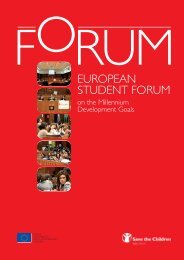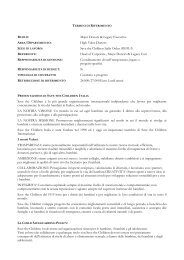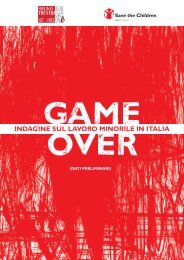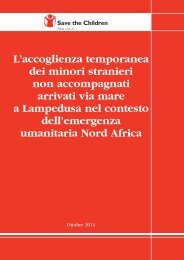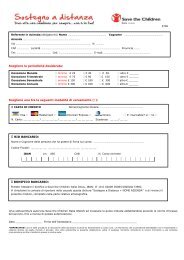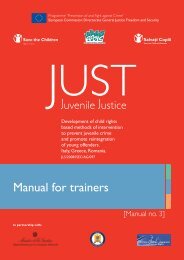FINAL REPORT - Save the Children Italia Onlus
FINAL REPORT - Save the Children Italia Onlus
FINAL REPORT - Save the Children Italia Onlus
Create successful ePaper yourself
Turn your PDF publications into a flip-book with our unique Google optimized e-Paper software.
IPART<strong>FINAL</strong> <strong>REPORT</strong>Development of a Child Rights Methodology to Identify and Support Child Victims of Trafficking4.3 TRAFFICKING OF CHILDREN FOREXPLOITATION IN FORCED LABOUR,ILLEGAL ACTIVITIES AND BEGGINGProfiles, methods of recruitment, border crossing,trafficking routes and forms of exploitationILLEGAL ACTIVITIESExploitation in illegal activities is not a well-known phenomenon in Italy, and victimsare not often identified as such, thus missing out on <strong>the</strong> support necessary for <strong>the</strong>irprotection and rehabilitation. <strong>Children</strong> of different ages and nationalities are recruitedand directed to steal and deal drugs by individuals who keep some or all of <strong>the</strong> earnings.Depending on <strong>the</strong> nature of <strong>the</strong> relationship between <strong>the</strong> adult and <strong>the</strong> child, this mayresult in a situation of trafficking, exploitation of varying degrees or simple acts ofcomplicity where <strong>the</strong> adult exercises no particular control over <strong>the</strong> child and takes noadvantage of <strong>the</strong>m.Cases of international trafficking are of particular concern, and have been identifiedamongst <strong>the</strong> following profiles: children from Romania of Roma origin, adolescent boysand girls from Romania of Roma origin, adolescent boys and those just come of age fromSenegal or Gabon, and o<strong>the</strong>rs of North African origin.<strong>FINAL</strong> <strong>REPORT</strong>Development of a Child Rights Methodology to Identify and Support Child Victims of Traffickingchild was caught more than once, and sent to several reception centres forunaccompanied minors until finally with <strong>the</strong> help of a psychologist he revealed what washappening to him.Social Assistant, Milan, 2006As for Roma adolescents, in Italy not all of <strong>the</strong>m are victims of trafficking orexploitation.In fact, adolescents are more likely to engage as a group in illegal activities without adultsupervision and share <strong>the</strong> profits evenly between <strong>the</strong>mselves. However <strong>the</strong> situation isquite different when trafficking occurs. In this case, in <strong>the</strong> country of origin adolescentsare convinced by <strong>the</strong> traffickers to engage in high-profit criminal activities, such as <strong>the</strong>ft,but in an independent way. The trafficker obtains <strong>the</strong> family’s consent with <strong>the</strong> paymentof a sum of money. <strong>Children</strong> travel on <strong>the</strong>ir own and may have correct papers givingguardianship to <strong>the</strong> driver of a coach and <strong>the</strong> person waiting for <strong>the</strong>m at <strong>the</strong> place ofdestination.Traffickers in Italy tend to use constant threats and physical abuse to keep <strong>the</strong>adolescents, who work as a group, in line. They live with <strong>the</strong> exploiter in illegal Romacamps where living conditions are quite poor, especially given that <strong>the</strong> victims arewithout family or o<strong>the</strong>r contacts within <strong>the</strong> host community, and <strong>the</strong> earnings are keptalmost entirely by <strong>the</strong> trafficker, who also confiscates <strong>the</strong>ir passport. The victims aremainly involved in pick pocketing and house burglary, as well as break-and-entering inshops. If <strong>the</strong>y are taken to a reception centre for unaccompanied minors, <strong>the</strong> traffickerusually rings to convince <strong>the</strong>m to leave, or if <strong>the</strong> child has left <strong>the</strong> group voluntarily, <strong>the</strong>trafficker may ring <strong>the</strong>ir parents who <strong>the</strong>n convince <strong>the</strong> victim to return to <strong>the</strong> group.IPART28Roma children from Romania are likely to be under 14 years of age, that is, under <strong>the</strong>age of criminal consent, hence not punishable with imprisonment if caught whilestealing. They are recruited in <strong>the</strong>ir country of origin, in agreement with <strong>the</strong>ir family,who profits from <strong>the</strong>ir exploitation, though in some cases <strong>the</strong> child may lack strongfamily ties in Romania, such as those who live in orphanages or in <strong>the</strong> care of guardians.The agreement with <strong>the</strong> trafficker is usually sealed with <strong>the</strong> payment of a sum of moneyfor guardianship of <strong>the</strong> child, and on <strong>the</strong> promise that regular returns from <strong>the</strong>iractivities will be sent to <strong>the</strong> family.The trafficker usually enters Italy by car with <strong>the</strong> child and <strong>the</strong> necessary guardianshippapers. Once <strong>the</strong>y arrive in Italy, <strong>the</strong> children are involved in criminal activities such aspick pocketing and house burglary. They work in groups, and suffer violence and threatsfrom <strong>the</strong> trafficker who is usually a Romanian adult of Roma origin. Fur<strong>the</strong>rmore, <strong>the</strong>yare also pressured by <strong>the</strong>ir families who call to encourage <strong>the</strong>m in <strong>the</strong>ir activity, in lightof <strong>the</strong> money <strong>the</strong>y stand to earn from it.When <strong>the</strong> children are stopped by <strong>the</strong> police, if <strong>the</strong>y are taken to penal facilities forminors, <strong>the</strong> traffickers seek to retrieve <strong>the</strong>m presenting false guardianship papers ordocuments proving <strong>the</strong>ir parental status. If this occurs to several children in a group, <strong>the</strong>exploiter is likely to move <strong>the</strong>m to ano<strong>the</strong>r city, like Milan, Rome, Naples, Verona,Pescara, or Florence.Due to <strong>the</strong>ir constant contact with <strong>the</strong> street, <strong>the</strong>se young victims are particularlyvulnerable to violence and abuse. They may also be <strong>the</strong> victim of sexual abuse, where <strong>the</strong>trafficker/exploiter uses <strong>the</strong>m, or forces <strong>the</strong>m, on a regular or casual basis, to prostitute<strong>the</strong>mselves (see profile above regarding “trafficking for sexual exploitation”).M. is a Romanian child from <strong>the</strong> Roma community of Calarasi who has sufferedexploitation at <strong>the</strong> hands of a Roma man, R., from <strong>the</strong> same city.This man contacted <strong>the</strong>family whom M had been living with for 10 years in Romania, and convinced <strong>the</strong>m to givehim custody of M for a few months in Exchange for approximately two hundred eurosfollowed by fur<strong>the</strong>r periodic payments. R explained that <strong>the</strong> child would be involved in<strong>the</strong>ft in Italy, but that he could not be arrested and he would be treated well. Once <strong>the</strong>yarrived in Italy (by car), <strong>the</strong>y lived in several unauthorised Roma camps, and in particular Msuffered unhealthy living conditions and isolation. M was used for <strong>the</strong>ft, mainly houseburglary, under R’s guidance/direction, who did not, however, participate in <strong>the</strong> crime.TheOn <strong>the</strong> o<strong>the</strong>r hand, those adolescents who enter Italy with <strong>the</strong>ir families tend to live with<strong>the</strong>m in illegal Roma camps and risk being taken advantage of by traffickers describedabove. This risk is mitigated by <strong>the</strong>ir strong family connections, however is still present.Fur<strong>the</strong>rmore, <strong>the</strong>re are o<strong>the</strong>r adolescents from Romania who leave <strong>the</strong>ir country oforigin of <strong>the</strong>ir own accord, and who are at risk of being recruited in Italy and exploited.They may come into contact with o<strong>the</strong>r youths from <strong>the</strong>ir own country and be tricked,or at least <strong>the</strong>y may be susceptible to <strong>the</strong>ir offer of friendship, and agree to join in someillegal activity with <strong>the</strong>m. The meeting may be a random occurrence, or it may take placein <strong>the</strong> context of <strong>the</strong> penal circuit, where <strong>the</strong> boy would have been caught for minor actsof <strong>the</strong>ft (probably necessary for his survival). Where those youths are actually under <strong>the</strong>control of an adult, exploitation is very likely to occur.Though <strong>the</strong> exploiter keeps most or all of <strong>the</strong> earnings from <strong>the</strong> victim’s activities, <strong>the</strong>yallow <strong>the</strong>m to drive cars, drink, take drugs and go clubbing. The victim can also counton a good lawyer should <strong>the</strong>y get into trouble. In return <strong>the</strong> exploiter expects loyalty to<strong>the</strong> group, and that <strong>the</strong> hierarchy be maintained. In this context, <strong>the</strong> lack of family ties isreplaced by a strong sense of group spirit fur<strong>the</strong>r instilled by certain stratagems such astaking possession of <strong>the</strong>ir passports for “safe-keeping”.Not much is known about <strong>the</strong> trafficking of adolescent boys from Senegal and Gabon,but it seems that <strong>the</strong> phenomenon is on <strong>the</strong> rise. Apparently, it is controlled by Mafiatypeorganisations who recruit boys in <strong>the</strong>ir country of origin, by deceit or with threats,and organise <strong>the</strong>ir (illegal) travel to Italy by boat across <strong>the</strong> Mediterranean or with falsedocuments by plane. In Italy, <strong>the</strong>se victims are involved in drug dealing on <strong>the</strong> streetsand transportation of heavy drugs such as crack, cocaine and heroin. They are underheavy control from <strong>the</strong> traffickers and subject to threats and violence, as well as enforcedgroup bonding. Fur<strong>the</strong>rmore, in order to evade police investigation and immigrationcontrols based on fingerprint recognition, <strong>the</strong> traffickers disfigure <strong>the</strong> victims’ fingersusing abrasive substances.Finally, according to <strong>the</strong> research findings, also adolescent boys from North Africancountries are exploited in Italy in illegal activities. Amongst <strong>the</strong>m, actual victims oftrafficking are rare compared to <strong>the</strong> number of cases of exploitation without trafficking.Where trafficking occurs, <strong>the</strong> victims are usually recruited in <strong>the</strong>ir home country by29



